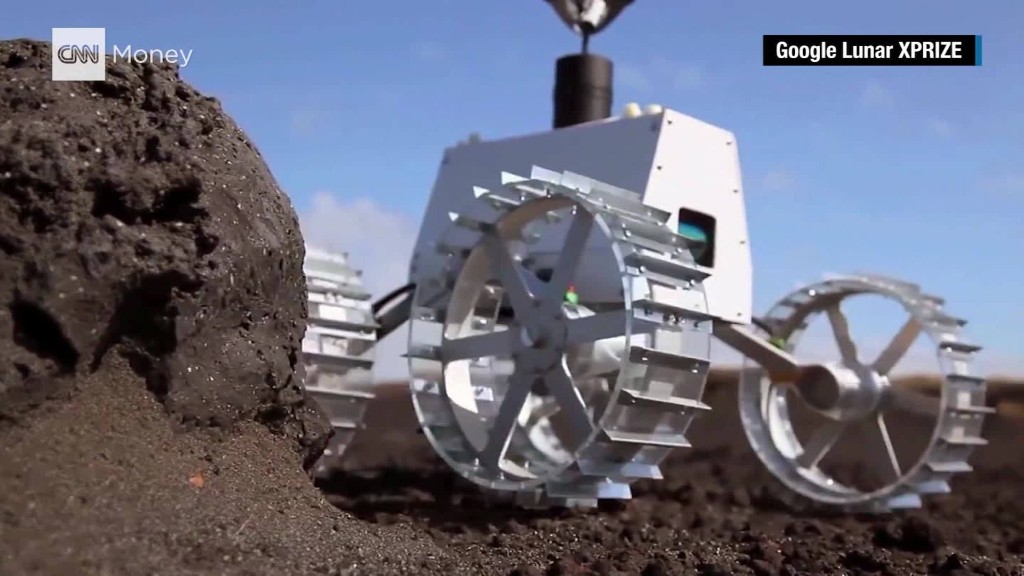
The Google Lunar XPrize competition is down to five finalists who are prepped to go after a landmark achievement in 2017 -- the first-ever privately funded trip to the moon.
Previously, only governments -- China, the U.S. and the Soviet Union -- have successfully completed trips to the moon.
But XPrize launched this competition in 2007 to stir up interest in putting more private money into space exploration. The grand prize is $20 million, and the teams have until December 31, 2017 to land an unmanned spacecraft on the moon, travel at least 500 meters and deliver a "mooncast" of high-definition video back to Earth.
The end of 2016 marked an important deadline for the teams. To stay in the competition, they each had to secure a launch contract guaranteeing the team will launch sometime before December 31, 2017.
More than a dozen teams from around the world entered the race, and on Tuesday XPrize announced the finalized list of five competitors that still remain:
SpaceIL
Homebase: Israel
The Rover: SpaceIL took a unique approach. Instead of developing a rover that drives, SpaceIL's rover will hop across the moon, taking 500 meter leaps.
The Launch: The team will use a SpaceX rocket named the Falcon Heavy. It's a suped-up version of SpaceX's Falcon 9 rocket, which has completed more than two dozen trips to space already. It's even taken several trips to geosynchronus orbit, which is about 20,000 km away. However, the moon is much further -- 384,400 km.
SpaceIL is scheduled for liftoff sometime in December 2017, SpaceIL CEO Eran Privman recently told SpaceWatch.
Goal: Of course the teams are hungry for that $20 million jackpot, but they're also interested in collecting interesting data. SpaceIL says it wants to "decipher the secrets" of rocks from the moon's magnetic crust.
"Although magnetized rocks were discovered decades ago, and astronauts returned some samples to Earth for research, the origin of the magnetic field presents an enigma — and an opportunity," Privman said.
Moon Express
Homebase: Silicon Valley, California
The Launch: Moon Express plans to launch on a rocket developed by a startup called Rocket Lab. The company is focused on developing relatively inexpensive rockets that can make trips to space more frequently. It's a risky pick, however. Rocket Lab is yet to conduct a test launch.
Moon Express is targeting a launch date "for the end of 2017," Moon Express CEO Bob Richards told Space.com in August.
Goal: This team wants to explore the moon's unknown treasures with the hope of one day returning some to Earth. "We envision bringing precious resources, metals, and moon rocks back to Earth," co-founder Naveen Jain said in an August press release.
Fun Fact: Moon Express wants to eventually launch a space tourism program and bring people to the moon for just $10,000.
Synergy Moon
Homebase: Multinational
The Rover: Synergy Moon is sending two rovers to the moon. One is a "virtual excursion vehicle" that has two HD cameras and will feed video back to Earth. The other will able to determine the mineral content of the moon's rocks and soil.
They've been named The Tesla Rovers, after famed scientist Nikola Tesla, the same man SpaceX CEO Elon Musk named his electric car company after.
The Launch: Synergy Moon will send its rovers to the moon aboard a Neptune 8 rocket made by Interorbital Systems -- a California startup that so far has only completed sub-orbital test flights.
They're scheduled to launch sometime "in the second half of 2017," according to the XPrize website.
Fun Fact: Two XPrize competitors -- Human Synergy Project and Interplanetary Ventures -- merged to form this team. Its 40-plus members are from more than 15 countries.
Team Indus
Homebase: New Delhi, India
The Rover: Team Indus's aluminum rover, dubbed ECA, will take a "variety of equipment, including cameras from the French Space Agency CNES," according to the team's website. It's expected to be one of the lightest rovers to reach the moon.
They're scheduled for launch on December 28, 2017.
The Launch: The team's rover will hitch a ride on a Polar Satellite Launch Vehicle, or PSLV, developed by the Indian Space Research Organisation. Liftoff is scheduled for "late 2017."
Hakuto
Homebase: Tokyo, Japan
The Rover: Hakuto's is tinkering with a "dual rover" system, consisting of one two-wheeled and one four-wheeled rover. They'll be tethered together while they roam the moon, and the smaller rover will be lowered into suspected "skylights" -- or dark holes on the surface of the moon -- to explore.
The Launch: Hakuto's rover will catch a ride on Team Indus's lunar lander, which is set to launch on December 28.
Fun Fact: Hakuto is Japanese for "white rabbit," and it comes from a Japanese tale about the image of a rabbit on the moon.

